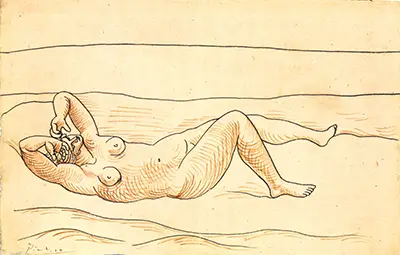There are very few practitioners of the visual arts who rival Picasso in the public consciousness: not only is his name famous across the world, it is inseparably attached to his distinctive style - a style that helped to form modern art as it is known today. The downside to his continued fame is that a lot of people around the world have picked up a reductive, stereotyped idea of what Picasso's art looked like. His signature works have been imitated and parodied to such an extent that it is easy for people to forget that he worked with a range of different techniques. His cubist pieces, although his most famous and influential work, form just one part of a wider oeuvre - the depth and breadth of which may be surprising to those who have only a passing familiarity with him.
"Reclining Woman at the Seashore" is an example of Picasso's less characteristic works. The visual style he has adopted with this image is far more representational than that of his cubist portraits. He has also used a much more restrained colour palette than in his better-known works. Few people aside from the most avid art lovers would even guess that Picasso was the artist upon looking at it. But dig deeper, and the mindset of Picasso can be detected within the image. Throughout his career as an artist Picasso sought to capture a childlike view of the world, in the belief that children's drawings possess a purity lacking in the refined artwork of adulthood.
"Reclining Woman at the Seashore" reflects this ethos: it is loose, naïve. The woman's anatomy is simplified, while the background is now more than a few lines - an abstract suggestion of a location. Any lover of art will be able to surprise and intrigue their friends with a copy of "Reclining Woman at the Seashore". Few casual observers will be able to guess that it was made by Pablo Picasso - and upon finding this out, few could fail to be impressed.

